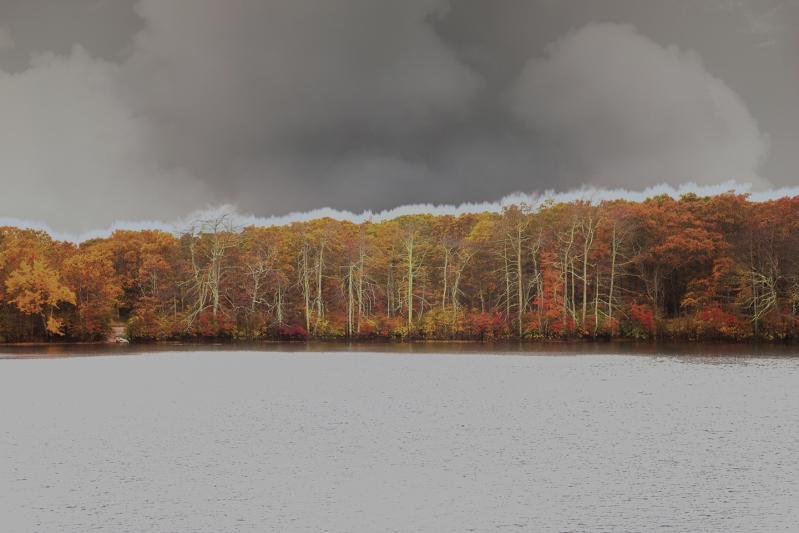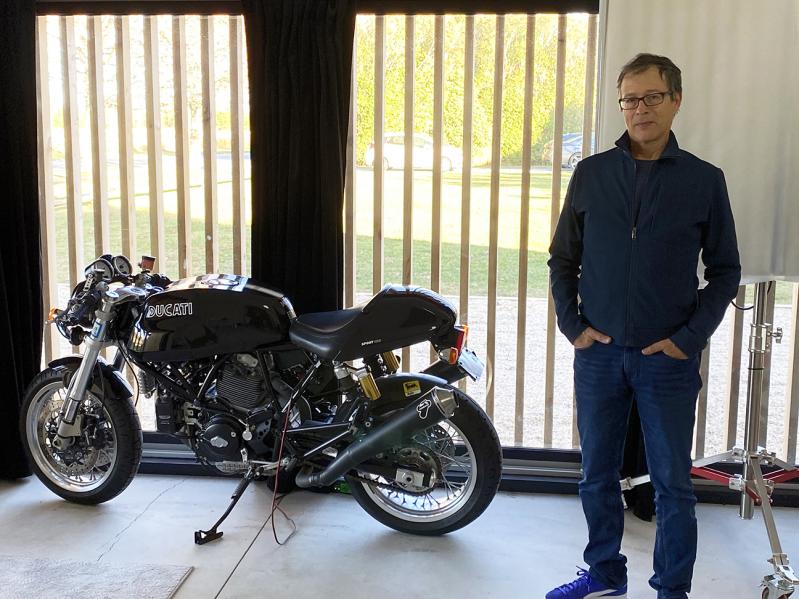Growing up in Lima, Peru, Jaime Lopez wanted to fly. Not as a passenger, but as a pilot, the occupation of his grandfather, father, and three of his brothers. "But my mother had had enough of people leaving and not knowing when or if they were going to come back," he said in his Sagaponack studio. Moreover, he wore glasses, "and in those days you had to have 20-20 vision."
It turns out his vision was good enough to lead to a successful career as a fashion photographer and, more recently, a fine art photographer. But as is so often the case in the arts, the route was circuitous.
The first taste of the medium came in the 1970s, when a friend of his father, who had a collection of cameras, lent young Lopez a Hasselblad, widely considered the Rolls-Royce of camera systems.
"Peru was in chaos in the 1970s," said Mr. Lopez, "and everything had to be exported to get some dollars back. There was no film." He found a way to trick the camera so it would advance without film. "I loved the object. I loved the sound and the feel of the camera in your hand and the movement when the shutter clicked."
But it would still be a number of years before that feel and sound would be second nature. In 1980 he moved to New York City to study graphic art at the Parsons School of Design.
"I wasn't learning enough," he said, "so I asked them if they would help me get an internship." The school's dean of photography gave him a specific piece of advice: Go to 100 Fifth Avenue, go to the 16th floor, and walk down the stairs, knocking on every studio until you find an internship.
A letter from the dean in hand, the first door he knocked on belonged to the legendary photographer Irving Penn. During his week there, Mr. Penn showed Mr. Lopez photographs he had taken when he went to Cusco, Peru, and rented the studio of Martin Chambi, one of the first important Indigenous Latin American photographers.
Next stop in that same building was a yearlong internship with a Japanese graphic designer, whose wife was the studio manager for Bill King, a famous fashion photographer at the time.
Mr. Lopez would visit King's studio on his lunch break and eventually landed an internship there. His job: cleaning the cyc, which is an all-white curved wall that served as a backdrop instead of background paper. "I had to run in with Fantastik and paper towels when the models were taking a break and clean the smudges."
But working for King launched him into photography, "because there was a huge difference between working for a graphic designer with discipline and quietness, and working in a studio where everybody was screaming or having fun, models coming in and out, fans blowing. Some people say being a fashion photographer is like driving a school bus full of kids." He was in his early 20s at that point.
Next he landed a job as an assistant to Alex Chatelain, also a fashion photographer. "He got me my first working visa in the U.S. and said, 'Why would you want to go to Peru, there is no fashion photography in Peru. Stay and I'll help you.' "
While still working in New York as an assistant, a shoot for the Spiegel catalog took place in Fort Walton, Fla., a beach town on the panhandle. "The photographer and I were there for three weeks, and the models would come and go from New York. One of the models, Marilyn Clark, an East Hampton native, came near the end of the job. One thing led to another, and here we are, almost 40 years later." They have two daughters, Raquel and Alexandra.
Soon after that assignment, he went out on his own, but because New York was only for established fashion photographers, he and Ms. Clark moved to Europe in the mid-1980s, living first in Milan, then in Madrid. The idea was to get work with European fashion magazines, starting with those of lesser quality because they would hire you, develop a reputation for your own imagery, move up to better magazines, and then return to New York.
A turning point came in the late '80s. He told a magazine he was working for that he and Ms. Clark were going to visit friends in Los Angeles. "I said, 'Why don't you give me some bathing suits, I'll do some pictures for you, bring them back, and, if you like them, great.' "
Instead of working with his wife, he cast the models. "And I got very lucky. I got to photograph Cameron Diaz, who was a junior model at the time, before she broke into movies. With bathing suits people don't want to do too much jumping because they don't want to show too much. But she had that energy and the pictures turned out well and they got published."
That layout led to more jobs, bigger and more creative layouts, and better magazines, among them Elle, Marie Claire, Hola, GQ, Woman's Magazine, Glamour, and Cosmopolitan, among many others.

The couple had bought a house in Sagaponack before moving to Europe, and returned there full time in 2000. Mr. Lopez continued to do commercial work for the next two decades, but also embarked on a series of East End landscape photographs that came to the attention of Coco Myers, a curator and founder of Folioeast, which represents artists and mounts exhibitions.
"I started photographing all these beautiful places, but I thought I've got to do something else." He embarked on a series he calls "Ominous Landscapes." Examples of both can be seen on the Folioeast website, with some featuring serene land and water views while others are ravaged woodlands, or seascapes threatened by vicious storm clouds.
Most of those landscapes are large, 23.5 inches tall by 72 inches long, and printed with a process called sublimation printing on aluminum. Most of the images have no reflection and, more important, "they are archival for as long as the aluminum lasts, which is forever. You can even hang them outside."
Four years ago Mr. Lopez found a potato barn on Sagg Main Street whose C. of O. allowed only an art studio. "I opened the door one day and said, I need a project, what am I going to do. I wanted to photograph the farmers around Sagaponack, I thought it was the last generation because none of them had kids." However, while he made many appointments, nobody ever showed up.
He then asked Ms. Myers to connect him with one of the other artists she represented. He was happy with the session and asked her to send somebody else. "I didn't know who they were until they opened the door to the studio. We would sit and have coffee and talk and then I'd say, let's go play. That's how the first book happened."

That book, "Hamptons Artists: The Current Wave," profiled in photographs by Mr. Lopez and words by Ms. Myers 48 artists living on the East End. Shot in both his studio and the artists' workspaces, each has an eight or 10-page layout similar to the ones he created for fashion magazines.
While that book was self-published, a second volume, "Light, Sand, and Sea: Hamptons Artists and Their Studios," will be published in May by Vendome Press, a New York publisher of art and illustrated books. Featuring close-up looks at 50 painters, sculptors, printmakers, photographers, and mixed-media artists, in addition to photographs by Mr. Lopez and text by Ms. Myers, it will have a forward by Monica Ramirez-Montagut, the director of the Parrish Art Museum.




